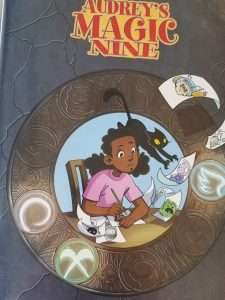
Title: Audrey’s Magic Nine
Author: Michelle Wright
Illustrator: Courtney Huddleston
Publisher and year: Penny-Farthing Productions Inc. 2018
Number of pages: 144.
Tags/Themes: Adventure, Diversity, Family, Fantasy, Fiction, Friendship, Graphic Novel, 2-3,e
Genre: fantasy, sequential art, graphic novel, adoption
Descriptive Annotation: Audrey is a 10-year-old black girl who has been in the foster care her whole life. Her foster parents neglected her and her foster siblings giving her little food, and when the news station reported it, Tabitha saw Audrey and wanted to adopt her. Tabitha and her husband overworked Audrey with piano, violin, ballet, and school work when all Audrey wanted to do was draw in her notebook. One night she finds a magic puppet from another world who was kicked out of his world from an evil magic queen. Audrey and her new friend Asa try to find his new friends while Audrey is learning how to live with her new parents.
The graphic novel does a good job showing Audrey’s drawings as a central piece to storytelling in the book .
Classroom Application: Audrey draws to help her cope and deal with any stress she has. The book can be used to encourage the children to use the arts as a way to express themselves. Children learning how to express and explain their thoughts or emotions will be very helpful as they grow up. Methods can be comic making, drawing, paintings, creative writing, acting and script writing, or sculpting. Students can do a writing piece filled with their emotion and do a companion piece of art to complement their writing.
Linguistic and Cultural Diversity Analysis: This book has a representation of the foster care system and highlights issues like child neglect, overcoming personal problems, and using art as a coping mechanism. It gives a sense that families come in different forms (step-parents, multi-racial families) teaching children not to make assumptions about others’ family structures. When in new or stressful family situations, the book teaches how to use expressive skills so family issues do not get bottled up causing any future emotional harm. The story also shows a strong female character who is brave and wants to help her friends. I might introduce this graphic novel by having the students describe their favorite super powers, what they admire in heroes, and what they don’t like about super villains. This can set up their interests with the super powered puppets, creating future empathy with the characters and a greater admiration for Audrey being brave throughout the story. “There were several young girls in the Mercer fosters home, ranging in ages 5-16 and allegedly subjected to such punishments as hours spent in a small, locked closet ” (12). This sets up the tone right away. This graphic novel is serious and straight to the point. It is not afraid to state the facts what life is like for some children. “But those people have put that poor woman in danger, just for taking pizza out of the trash ” (73). This shows the empathy Audrey has the for the world. Even though she has been is foster care where she can’t express her emotions, she is still seeing the beauty in people and wants everyone to be valued.
